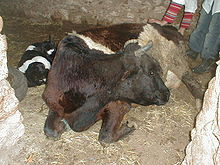Milk fever
Milk fever , also uterine palsy or calf fever , is a disease in mammals that can occur in dams around the time of birth and is caused by a reduced calcium content in the blood serum ( hypocalcemia ). It differs fundamentally from the so-called milk fever that occurs in humans at the time of milk injection on the 3rd or 4th day in the puerperium, which is caused by a milk congestion .
meaning
This disease is of particular importance in cattle , sheep and, less so, in dogs .
In today's agriculture it is one of the most common diseases in dairy farming. Due to the ever increasing milk yield of individual cows, the proportion of cattle with "milk fever" is also increasing rapidly. As a rule of thumb, the following can apply: the higher / greater the milk production, the greater the likelihood of a calcium deficiency.
etiology
During pregnancy or pregnancy, the body has a “normal” need for calcium . The necessary amount is taken from food or feed. During lactation , a considerable amount of calcium is removed with the milk . The body can also adapt to this by absorbing a larger proportion of the calcium from food. The absorption is controlled hormonally by the parathyroid hormone and is closely related to the phosphate metabolism. The birth of the fruit represents a transition between the two metabolic layers with the problem that the absorption of calcium from the feed has not yet adapted to the release into the milk. This leads to a sudden drop in the calcium level in the blood (free calcium).
Clinical symptoms
Calcium fulfills various functions in the body. One of these is found in the nervous system or in the muscle cells: Calcium is necessary to convey action potentials in muscle contractions . If there is too little calcium, the muscles can no longer be contracted. In the case of animals, this ultimately leads to the animals becoming stuck, i. i.e., they can no longer be moved to stand up. If the calcium deficiency persists, it inevitably leads to cardiac arrest (the heart consists mainly of muscles) and thus to death of the animal.
Basically, the symptoms and the course differ in cattle and dogs.
- Cattle: Typical time of occurrence is immediately after birth until about 2 days afterwards. Beginning with a staggering gait, stumbling and sliding away of the rear extremities, there is a progressive inability to get up ( lying down ). The classic form of lying in the chest position with the head on the chest wall is increasingly being replaced by various position variations with the head flapping around wildly, which is often an indication of a simultaneous phosphate deficiency. The animals initially have an increased pulse rate ( tachycardia ) and, in contrast to the disease term milk fever, a drop in body temperature ( hypothermia ). Often the general condition or the consciousness is disturbed to the point of complete apathy ( indifference ). With increasing duration, the muscle contractions and thus also the heart rate and body temperature drop extremely and lead to death within hours in about 75% of the animals without treatment.
- Dogs: Bitches of small to medium-sized breeds are mainly affected. In contrast to cattle, the disorder often only manifests 1 to 2 weeks after birth. Starting with slight muscle tremors, anxiety and an increasingly stiff gait, cramps can progressively develop, which then also lead to the person becoming stuck. In contrast to cattle, the body temperature often rises to over 40 ° C and consciousness is not disturbed. The masticatory muscles are partially paralyzed and the animals salivate heavily. In severe, undetected cases, demineralization of the bones and overactive adrenal gland can also occur.
prevention
Various methods are used in milk production to prevent the disease. In recent years, attempts have been made to increase the calcium level of the animal by means of vitamin D3 injections carried out approx. 10 days before the calculated due date and to prevent it from sliding into the deficiency state, but there is a narrow time window here. Another approach is to give the animal low-calcium feed for a longer prenatal period or additional feed that binds the calcium and makes it unusable for digestion in order to activate the body's own calcium mobilization mechanisms. This so-called transit feeding seems to prove itself with exact application (different stages over at least three weeks). Oral administration of calcium preparations immediately after birth in particularly endangered animals (= cows with high milk yield) has also proven successful. Attempts are also made to reduce the potassium content in the dry cattle ration , as potassium has the greatest influence on the animal's acid-base balance.
treatment
The cause of the disease was only discovered in the 1930s and 1940s. Until then, therapy consisted of insufflation (blowing) of air into the udder of the affected animal. The success of the method was due to the increased pressure in the udder, as this resulted in less milk being produced and thus the loss of calcium decreased.
The therapy currently used consists of topping up the calcium level in the blood by means of infusions of solutions with a high calcium content. Depending on the clinical picture, phosphorus is also supplied.
Individual evidence
- ↑ Reduction of the risk of milk fever through targeted ration design ( Memento from October 22, 2013 in the Internet Archive )
Web links
- Mountain Farmer Advice Service, Bolzano (PDF; 326 kB)
